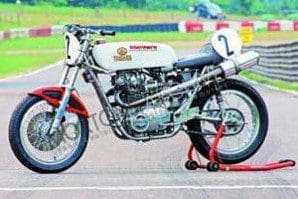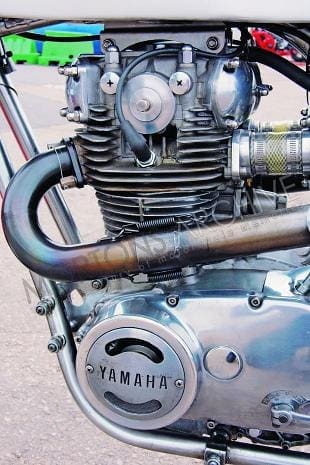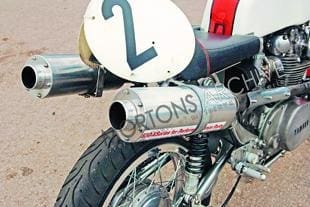
In the autumn of 2002 Richard Cheetham, having celebrated victory in the CRMC’s Honda UK sponsored 350cc twins Championship, on his Honda, was looking round for a new challenge. The Sheffield-based electrical engineer had enjoyed several years of successful production and club racing and had prepared his K4 himself, but now he fancied something bigger, albeit preferably with enough similarities to the 350 to utilise the experience he had painstakingly built up. He wasn’t afraid to stray from tried and tested routes, but as is often the case, financial constraints limited the options available. One of Richard’s regular suppliers of K4 spares also had a plentiful stock of imported 650cc XS Yamaha engines, and their price tag tempted him to take a closer look into the engine’s potential.
A study of the engine suggested there was scope within the design to improve the state of tune to race standards, plus there looked to be enough reserve strength in vital components to handle the extra power developed. He was not alone in coming to this conclusion, a few UK sidecar crews have used the XS engine for some time, while during the 70s, Kenny Roberts used the motor in his flat track racer to take the coveted No 1 plate. Further evidence came from Yamaha themselves, who had enough confidence in the motor to list a factory race kit. It is a tribute to the designers of the engine that although it was Yamaha’s first production four-stroke, it went on to be their best-selling model to date and accounts for the ease with which materials can still be sourced.
Having decided to tackle the XS Yamaha, Richard first spent two years in the workshop followed by 18 months’ development on track to arrive at the well-engineered bike we see today. 2005 was the bike’s first season on track and to finish runner-up in 1300cc twin’s class is a reflection of how thorough the workshop stage of development was.
 The engine features a pressed up crankshaft incorporating caged roller bearings for the main and big end bearings, housed in a horizontally split crankcase, driving a single overhead camshaft by chain – more than enough similarities with the 350 Honda for Richard to be confident he could make it work. Most tuners take out the original capacity of 653cc to 750cc and retain the reliability of the standard setup. Some have taken it further still, as it’s not too difficult to go to 840cc, but the extra cubes come with strings attached, in particular problems with the crank twisting and an increase in vibration. Richard has an 840cc engine and has tried it with the re-phased 90-degree crank that’s popular with American riders, but found that although vibration is reduced, the crank was still a problem. With the help of Tony Dawson, of Astralite wheels and Scitsu rev counter fame, new crank pins have been produced and the problem is now being rectified.
The engine features a pressed up crankshaft incorporating caged roller bearings for the main and big end bearings, housed in a horizontally split crankcase, driving a single overhead camshaft by chain – more than enough similarities with the 350 Honda for Richard to be confident he could make it work. Most tuners take out the original capacity of 653cc to 750cc and retain the reliability of the standard setup. Some have taken it further still, as it’s not too difficult to go to 840cc, but the extra cubes come with strings attached, in particular problems with the crank twisting and an increase in vibration. Richard has an 840cc engine and has tried it with the re-phased 90-degree crank that’s popular with American riders, but found that although vibration is reduced, the crank was still a problem. With the help of Tony Dawson, of Astralite wheels and Scitsu rev counter fame, new crank pins have been produced and the problem is now being rectified.
First gear
The gearbox is just as Yamaha made it, which means that first gear is too low to be of much use – unless your season takes you to the tight hairpins of such as Oliver’s Mount, Scarborough. The very first XS engines did have a slightly higher first gear ratio, which Richard has installed in his motor and while it helps, it’s no substitute for a pukka close ratio cluster.
The clutch needs stronger than standard springs to avoid slip, while alternative ratio primary drive gears reduce the load on the gearbox as well as the clutch.
Wiseco produce forged pistons for the XS but in respect for the con-rods, they do need to be trimmed a bit. Removing metal from the underside of the crown will see the American piston down to race weight and quickly back in balance with the crank.
The valves remain as standard XS2 – 41mm inlet, 35mm exhaust – but Richard has flowed the ports, though he says, “It could be better so there’s more to come yet.” They are opened courtesy of a Phil Joy 234 profile camshaft, while the R&D valve springs ensure the relationship between the valves and pistons remains intimate but not physical.
The traditional fuel mix of 12:1 is entrusted to a pair of 36mm Mikuni VM carbs that have been carefully set up by Richard. There are myriad combinations of jets, slides, needles and needle jets available for these instruments, so with patience you can be rewarded with a perfectly carburating motor.
Rex Caunt supplied the PVL high voltage sparks for the Yamaha and an excellent instrument it is. Using a rotating magnet, rather than a lead acid battery, to generate the electrical energy, is more reliable and this piece of German technology is proving much more robust than some of its self-generating ancestors.
The flamboyantly styled exhausts were fabricated by Richard, “I had a slab-sided picture of Kenny Roberts’ flat tracker, so using the back wheel as a gauge, I simply used a set of dividers and scaled them up. I also had some documentation from the original Yamaha XS race kit, which gave dimensions of the header pipes, so it was fairly simple really.” Likewise the fork braces were bored and shaped up by Richard and he also made a batch of 20 footrests and pedal assemblies – one of which graces the Davidson Honda!
The engine develops 71bhp at 7000rpm, with a spread of power that allows racing on the standard gears without losing too much to the opposition with close clusters. This user-friendly delivery of power was demonstrated at the CRMC 2006 season opener, held at a wet Mallory Park. Giving away 10-15bhp to the triples, Richard finished fourth in the 1300cc race, only 1.6 seconds behind the winner Paul Dobbs on the Lidgate Triumph, and set the second quickest lap time.
 Standard XS
Standard XS
Richard’s bike utilises the standard XS roadster frame, a typical period design with twin down tubes cradling the engine. This example came from the USA in exceptional condition, straight, and complete with the original decals. At first glance the frame appears to be chrome or nickel plated, but is in fact painted, and has proved quite durable after a couple of seasons’ use. Suspension technology has come a long way since the Yamaha design team first put pen to paper, and working with the original 1972 components, Maxton Engineering have re-valved the front forks and produced a pair of rear dampers to bring the XS suspension up to classic racing standards.
So what’s it like to ride? Richard started the bike with a push down the gentle slope of the Mallory Park paddock and let the Kenny Roberts inspired exhaust announce its presence as the engine warmed through. The first start up of the day needed choke, but within a short space of time can be knocked off as the motor settles down to a 1500rpm tickover. Richard took the bike out for a few laps to make sure everything was in order, prior to letting me loose with his pride and joy. I watched his first two laps from pit lane, then left to don my leathers, only to sense that the exhaust note of the big Yamaha had gone AWOL. A return to pit lane revealed the silent bike parked on the far side of the start line with a broken throttle cable. Had Richard brought resources to recover the situation I wondered, but you don’t win championships without carrying such basic spares as cables, and sure enough within half-an-hour the carbs were reconnected to the twist grip and we were ready to go.
Mallory Park
The low first gear gives the clutch an easy time in the paddock and with the controls all in positions to my liking we are off to enjoy Mallory Park on the XS2. Exiting the pit lane on a warm afternoon to a dry track the big twin is soon in its stride and not too fussy, at this stage, which gear it’s in, such is the spread of power. The gear pedal movement is longer than most race setups, but does have the compensation of a light action. I make the upward changes without disturbing the clutch and the selectors swap cogs as quick as my foot will move. The arrangement is a left-foot change, one up and four down. As this is opposite to my own Honda I need to reprogramme my brain for the afternoon if embarrassment, or worse, is to be avoided. After a few laps we get to know each other and press on a little quicker to try the handling and brakes.
Tip the bike into Gerard’s on the overrun and the braking effect of the twin soon drops enough speed to permit the power to be fed in, which settles the suspension. Once settled the bike can be pushed harder, a bit at a time, and its limits explored. Fortunately on this particular practice day Mallory have not castrated Gerard’s with the new chicane and I am able to enjoy this superb corner to the full. As the corner speed is increased the front shakes its head a little, but by this time I am confident that’s all it’s going to amount to, and it’s not going to be the limiting factor on how fast the corner can be taken.
Exiting Gerard’s wide on the left and flat in fourth, the bike is gently steered across the track to line up Edwina’s chicane where the brakes have to slow up over 500lb of bike and rider. (The bike weighs 330lb). Richard’s XS2 retains the original single disc front brake, a type Yamaha also used on the early TZs, and it works well with plenty of feel through the lever. Ferodo pads are used, and are still available, but don’t last too long with the work they have to do every 1.39 miles round Mallory Park.
Through the left-right flick of the chicane, the straight wide handlebars come into play. They give plenty of leverage and so the steering feels lighter, helping overcome the natural reluctance of the road frame, with its conservative head angle, to change direction quickly. It’s only when you try to follow a well ridden modern bike through Edwina’s that that your impressions are put in perspective, and even the nostalgic haze of the classic racing scene cannot obscure 35 years of chassis development.
 As soon as you are clear of Edwina’s, the Lake Esses are upon you, with the bike accelerating hard through the gears. The correct racing line is essential if you are to try and keep it nailed all the way to the hairpin, albeit with a short shift to avoid an upward change right in the middle of the right-hander. Through the right and left sweeps the Yamaha feels stable and sure footed, exhibiting less of the lively front end feel that was in evidence at Gerard’s.
As soon as you are clear of Edwina’s, the Lake Esses are upon you, with the bike accelerating hard through the gears. The correct racing line is essential if you are to try and keep it nailed all the way to the hairpin, albeit with a short shift to avoid an upward change right in the middle of the right-hander. Through the right and left sweeps the Yamaha feels stable and sure footed, exhibiting less of the lively front end feel that was in evidence at Gerard’s.
Approaching the hairpin, I use the braking point by the big tree on the right, gently squeezing the front brake lever to transfer weight to the front tyre, thereby increasing its grip, then rapidly building up lever pressure to achieve maximum braking. Simultaneously applying as much rear brake as the rear tyre will tolerate without locking the wheel, I drop two gears to take the hairpin with a wide sweep in second, (road ratios don’t forget) ready for the short sprint to the Bus Stop.
I also tried the alternative route, by moving to the right after the big tree and tracking tight up the inside to the apex, dropping into bottom gear at the very last moment. If the braking has been judged to perfection, the hairpin can be ‘squared off’ on a tight line, and advantage taken of the bike’s low first gear in the sprint to the Bus Stop. The Yamaha is never going to flick through such a tight chicane with the greatest of ease, but once again the wide bars come into their own and the bike can be persuaded, with a bit of brute force, to wriggle through at a higher speed than it really should.
The Bus Stop added a new dimension to the Devil’s Elbow, the potential high side, if you’re not careful, but at the same time took much of the exhilaration out of this downhill sweep in its original guise, and unless a gear is missed, rarely do track positions change between the Bus Stop and the chequered flag. Once through the high side zone it’s a case of hard acceleration, keeping as tight a line (shortest distance) as the bike will carve, and, in the case of this unfaired machine, minimising the wind resistance by getting the body as low as possible as soon as possible.
In conclusion, Richard has developed his XS2 into a clubman’s racing machine for the F750 and 1300cc twins classes and shown that it is capable of competing with all bar the front running bikes that are costing considerably more to build and maintain. A troublesome wrist and forearm reduced Richard’s 2006 season to a couple of outings and if a cure is not possible, may bring further development to a halt. Should that be the case, the XS2 may end up wearing a ‘for sale’ sign, along with the several engines and numerous spares. Whatever the outcome, Richard is happy to supply advice, information and race components to anyone interested in the big Yamaha. My thanks to Richard and Mallory Park for use of the bike and tarmac respectively.



